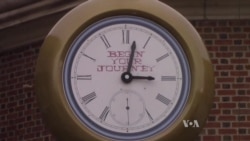It's possible to travel back in time - sort of - at a history center in Indianapolis. All that separates you from a momentous day 200 years ago is a curtain of fine mist.
Step through, and you find yourself in 1816, in a room with the men who were drafting the constitution for a new state to be carved from the Indiana Territory.
Angela Giacomelli, Exhibitions Researcher at The Eugene and Marilyn Glick Indiana History Center, says the interactive bicentennial exhibit is designed to help visitors personally connect with the past. "[It's] supposed to be kind of a whimsical way to step back into time. People step through the mist, and they’re placed in the room that has been recreated to look like the room where 43 delegates met down in Corydon, Indiana to write the state’s first constitution."
Actors and the Constitution
The museum employs about 30 part-time players to interact with visitors in the time travel areas. Guests are greeted by such historical characters as Dennis Pennington, a Harrison County Delegate and anti-slavery advocate, played by actor Michael Redmond. He explains the idea is to make history come alive by having conversations with visitors as opposed to giving a historical presentation.
"We invite them to enter into a conversation with us by simply pointing out that we’ll be working on the article concerning slavery later in the day. That usually breaks the ice."
On this day, in late 1816, Pennington is meeting with Jonathan Jennings, who would later become Indiana’s first governor and Representative Robert Hanna. While technically Indiana is supposed to be a free state, a surprising number of settlers in the untamed territory still own slaves.
Giacomelli pointed out, "So the men at this particular convention are talking about equality, the value of different human beings and if they should have a say in government. That completely relates to topics today." Other matters under constitutional consideration included education, personal liberties, and the banking system—all issues Indiana and the nation still deal with today.
Re-creating History
During the two years it took to plan the exhibit, Daniel Shockley, Director of Museum Theater, says they did a tremendous amount of research to find the stories of the people involved in telling the writing of the first constitution. And while the museum tries to be historically accurate, it does take some liberties. For example, 21st century men and women are welcome to take part in the proceedings, but women were not allowed in the actual meetings, as it was considered impolite to expose them to the messy business of politics.
And some things were just lost to history. "The room didn’t exist in any photographs," Shockley said, adding, "It was before photographs."
However, Giacomelli says, they knew the delegates met in a repurposed home because the capitol building was not finished yet. So, writing in the history center's blog, she says "My coworkers and I read up on typical 1816 architecture, decor and furniture. We knew the delegates would not have met in a primitive cabin, but they would not have met in a palatial home, either. Instead, we set the convention in a standard-looking room with some ornamentation, but overall very basic in appearance. To signal the fact that the delegates met in what used to be a home, we included a built-in bookshelf, a large window and a modest fireplace."
Outside the time travel area, the interactive experience continues with touchscreen displays that invite guests to participate in live-tally voting on such issues as the balance of power among different levels of government, and personal liberties.
Shockley hopes by bringing the past alive, visitors will learn something about the present.
"We have to work together, just like these gentlemen have to work together," he said. "They didn’t know each other. They may not have particularly all cared for each other. But they had to work together with one common goal."
The exhibit will remain open through the rest of the year to give everyone a chance to step back in time and experience Indiana’s history. It was admitted to the Union on December 11, 1816, as the 19th state.










